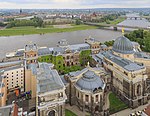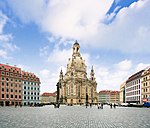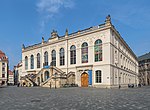Frauenkirche, Dresden

The Dresden Frauenkirche (German: Dresdner Frauenkirche, IPA: [ˈfʁaʊənˌkɪʁçə], Church of Our Lady) is a Lutheran church in Dresden, the capital of the German state of Saxony. An earlier church building was Catholic until it became Protestant during the Reformation. The old church was replaced in the 18th century by a larger Baroque Lutheran building. It is considered an outstanding example of Protestant sacred architecture, featuring one of the largest domes in Europe. It was originally built as a sign of the will of the citizens of Dresden to remain Protestant after their ruler had converted to Catholicism. It now also serves as a symbol of reconciliation between former warring enemies. Built in the 18th century, the church was destroyed in the bombing of Dresden during World War II. The remaining ruins were left for 50 years as a war memorial, following decisions of local East German leaders. The church was rebuilt after the reunification of Germany, starting in 1994. The reconstruction of its exterior was completed in 2004, and the interior in 2005. The church was reconsecrated on 30 October 2005 with festive services lasting through the Protestant observance of Reformation Day on 31 October. The surrounding Neumarkt square with its many valuable baroque buildings was also reconstructed in 2004. The Frauenkirche is often called a cathedral, but it is not the seat of a bishop; the church of the Landesbischof of the Evangelical-Lutheran Church of Saxony is the Church of the Cross. Once a month, an Anglican Evensong is held in English, by clergy from St. George's Anglican Church, Berlin.
Excerpt from the Wikipedia article Frauenkirche, Dresden (License: CC BY-SA 3.0, Authors, Images).Frauenkirche, Dresden
Neumarkt, Dresden Innere Altstadt (Altstadt)
Geographical coordinates (GPS) Address Phone number Website External links Nearby Places Show on map
Geographical coordinates (GPS)
| Latitude | Longitude |
|---|---|
| N 51.051944444444 ° | E 13.741666666667 ° |
Address
Frauenkirche (Kirche Unserer Lieben Frau)
Neumarkt
01067 Dresden, Innere Altstadt (Altstadt)
Saxony, Germany
Open on Google Maps
Phone number
Website
frauenkirche-dresden.de
External links
Experiences
Is this place worth visiting?
Beautiful church, The bright color inside and outside makes it look very cheerful, warm and inviting.









